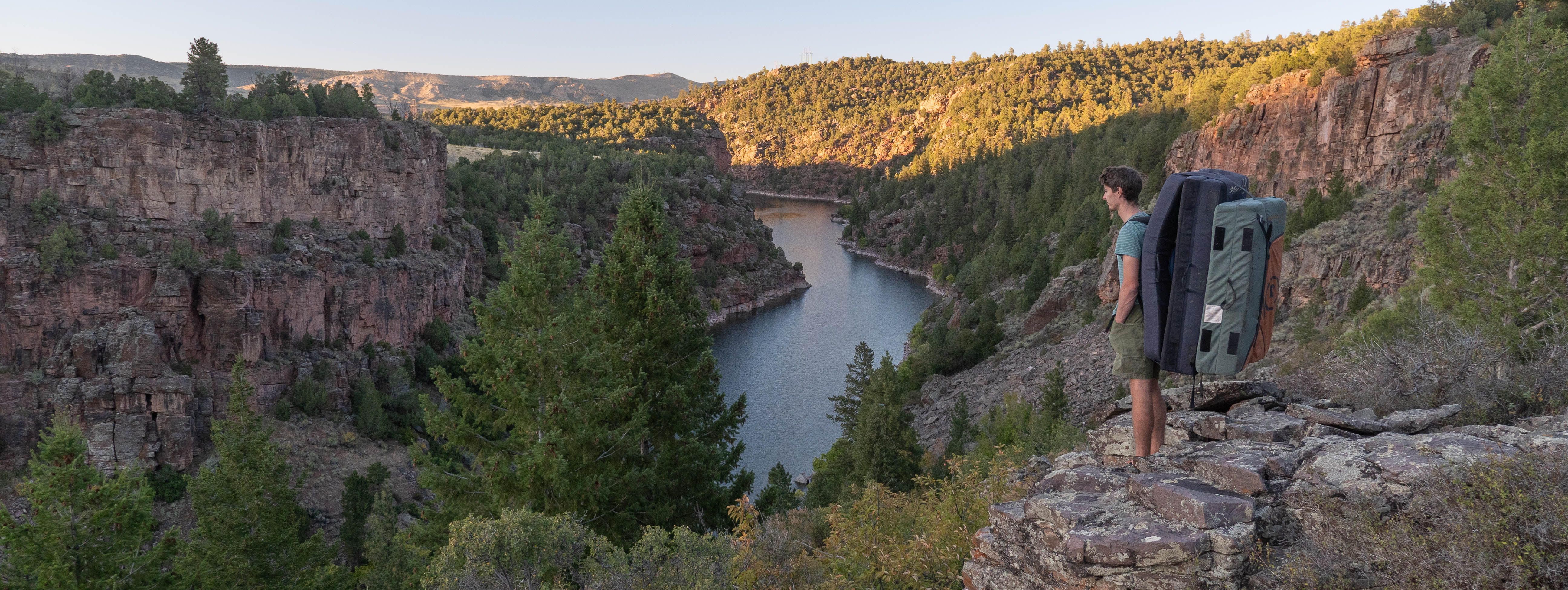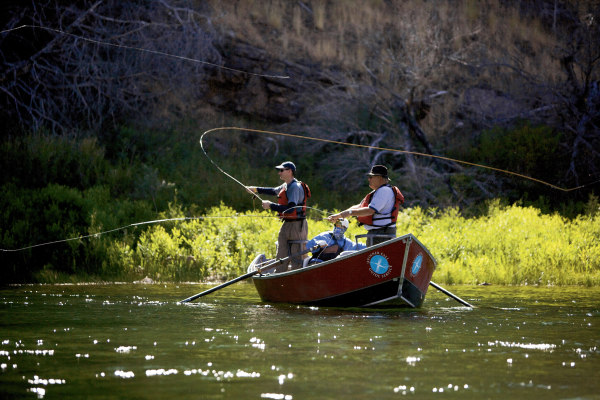
Bouldering Is Catching Fire in Flaming Gorge
This article is sponsored by Flaming Gorge
Tucked away in Utah’s northeast corner (the easternmost northeast corner, not the other one), you’ll find Flaming Gorge Reservoir, a mecca of fly fishing, watersports and wildlife viewing. Most Utahns, Wyomingites and Coloradans know it as a place to enjoy pristine waters, walk through quiet woods and gaze at the fiery red cliffs from which the region takes its name. But Flaming Gorge is also quickly becoming known as a hub of another outdoor pastime: bouldering.
Bouldering, or climbing without a rope on boulders and other short routes, has grown in popularity with the rest of the sport in recent years. And while you’ll find plenty of folks on the bouldering walls at your local climbing gym, fewer people venture outside to explore their regional rocks and local limestone.
If you’re looking to try bouldering in Utah for the first time, want to climb outside for a change or need routes you don’t already know like the back of your handholds, the boulders in Flaming Gorge are well worth the trip. Even if you do more crashpad napping than climbing, it’s still hard to find a climbing destination with more gorge-ous views than this one.
What Is Bouldering?
Do your palms get sweaty every time you see the speck of a climber hundreds of feet above the ground? If so, bouldering is right up your alley. Or, more appropriately, right up your canyon. Unlike sport and trad climbers, who scale towering cliff faces and canyon walls, boulderers usually only climb about 10-15 feet above the ground on — you guessed it — boulders. Because of these relatively low heights, no ropes are required, and climbers either down-climb from the top of their route or drop onto a crash pad, guided by their climbing partners, who serve as spotters.
Due to its simplicity and accessibility, many people consider bouldering to be the purest form of climbing. As Flaming Gorge climber Brian Tonetti put it, “Really, the only required equipment is climbing shoes. You can go out, find a rock and start climbing.” Although he added, “You might want to bring some pads for safety.”
Along with those crash pads, you should also bring some friends, and not just because it gets lonely in the woods by yourself. As you climb, your fellow climbers will stand below you and spot you. As spotters, their job won’t be to catch you when you fall but rather to guide your fall into the mat so you won’t hit any rocks in the fall zone. And although the pads are an added bit of equipment, you’ll usually only need one or two for the group, so the cost is still a lot lower than that of trad or sport climbing. A crash pad is also the most comfortable camping chair/bed in the entire pantheon of outdoor equipment, so it’s worth the investment anyway.
The Spark of a New Bouldering Hot Spot
If the bouldering is so incredible in Flaming Gorge, why is this the first time you’re hearing about it? Until recently, it’s been something of a hidden gem in the climbing community. The word is getting out, though, and unlike those overpriced apartment buildings across town, this is one up-and-coming area that’s worthy of the hype.
What makes Flaming Gorge a special place to climb? According to Tonetti, “The sort of exploration of it has been really, really fun. You know, coming up on new boulders around the corner. Just the amount of rock out here is pretty incredible.” And for an area that’s smack dab in the middle of three of the West’s wildest states, it’s pretty fitting that Flaming Gorge offers so much exploration for modern-day pioneers of climbing.
While some of the routes, or “problems,” as they’re referred to in bouldering, have been named and rated, many more are ready for you to make a first ascent. There are plenty of boulders to find on the trails and paths of Flaming Gorge, and completing a problem is as simple as just getting to the top. As for the rock? Tonetti described it as “really featured,” with “some really interesting texture and holds.”
So you’re pretty likely to throw the dart at a map and find great rock with plenty of grip and a stunning backdrop in Flaming Gorge. But if you’re looking for a sure thing, we can steer you towards some of the area’s densest bouldering spots.
Where to Go
Two of the best bouldering areas in Flaming Gorge are located by Cart Creek Bridge, off of state Route 191. One of these areas, known (fittingly) as the Cart Creek Bridge Boulders, consists of several smaller groups of boulders. Climbers can easily make their way from the Bat Cave area, with problems like “Riddler” and “Commissioner Gordon,” over to the Flintstones boulders, which surprisingly don’t feature a dino-powered pulley. Other boulder groups in the area include Cadillac, Nip Tuck and Flat Head.
At the Cart Creek Bridge Boulders, you’ll find lots of variety for novices, intermediates and experts alike. There are plenty of boulders to go around, too, so beginners can do their own climbing and not have to watch the experts all day. (They’ll have plenty of time to do that later, after their arms turn into jelly.)
With clear directions and route descriptions online, the Cart Creek boulders should be easy to find. For a more adventurous outing, meanwhile, head across Route 191 to the Lowline Boulders. That’s where the element of exploration unique to Flaming Gorge starts to come in. The Lowline area features incredible problems around every bend of the trail, and even though they haven’t all been rated or named yet, they’re sure to deliver. In the words of one early Flaming Gorge climber, “When I found this area in April of ‘07, I almost cried.”
That same climber estimates that there are over 200 problems in the Lowline area, and only about half of them have been climbed so far. Like the Cart Creek Bridge area, the Lowline Boulders have something for everyone, from beginners to experts. The pros will probably find a little more to love here, though, with some great problems and really interesting rocks at their level.
The Lowline Boulders are a truly hidden gem, so getting there is a bit tricky. Park at the Lowline Trail parking area, then travel to the south end of the parking area and pass through the Forest Service gate on an old two-track road. Follow the road for approximately 0.6 miles as it curves down towards Cart Creek. You might see a few boulders on the way, but the main climbing area is across the creek.
Follow the road to the creek, making sure to not follow any turn-offs beforehand. At the creek, you might see the remnants of a small wooden bridge, but you’ll have to rock hop across the water, taking extra care during spring runoff and high water. It shouldn’t be hard to find the trail on the other side, although it gets steeper on this side of the creek. Hike up the slope until it begins to bend to the left. That’s where you’ll see the beginning of a cliffside, with bouldering paradise to follow for the next half mile or so.
Downtime Fun
The best part about climbing in Flaming Gorge might be all the fun things you can do while giving those climbing muscles a well-deserved break. If your arms aren’t too tired to cast a rod, you can enjoy one of the best fishing destinations in the country. In addition to the diverse fisheries, which include lake trout, rainbow trout, brown trout, kokanee salmon, channel catfish, smallmouth bass and burbot, you’ll get one heck of a view while you wait for a nibble. Visit in late September and early October for cool climbing temps and a chance to catch the kokanee salmon swimming upstream in their fiery red, end-of-life hue.
Elsewhere on the water, you can enjoy boating, stand-up paddleboarding and river rafting. Boaters and other water sports enthusiasts will find plenty of wide open waters to play in, along with three full-service marinas.
Rafters should be especially stoked about the opportunity to explore the Green River in Flaming Gorge, with various sections (A, B and C) to choose from and local outfitters that will pick you up from common outlet points. Dutch John Resort, Flaming Gorge Resort and Trout Creek Flies each have shuttle services for hire. The river features some mild to moderate whitewater in some parts, but is usually manageable for everyday rafters. Check with your shuttle operator or look online for rapid conditions before your trip.
And what about when you’ve been sending it so hard on those boulders that you can’t even leave your camp chair? In Flaming Gorge, you can easily transform “sitting” into “wildlife viewing” with just a pair of binoculars and a dream. In addition to hundreds of different bird species, including bald eagles, ospreys and wild turkeys, you might see moose, mule deer, pronghorn antelope, bighorn sheep, elk, river otters and yellow-bellied marmots. You might also see black bears, bobcats and mountain lions, but we’re guessing your legs will start working quickly if that happens.
Whether you’re a bighorn sheep or a big-armed human, it’s an exciting time to climb in Flaming Gorge. After all, it’s not every day you get the chance to join the early wave of climbers flocking to a region. Make the trip today, and tomorrow you can be a grizzled old-timer talking about how great things used to be.
Besides, climbing is at its best when you feel like you’re leaving all your problems on the ground. And in a relatively untouched place like Flaming Gorge, it’s even easier. That’s what Brian Tonetti thinks, anyway. “It kind of teaches you that the life stuff, the life issues, are not super important, especially when you’re outside climbing on rocks,” he said.
With pristine wilderness and uncrowded crags as your backdrop, Flaming Gorge allows you to step into a world where the only things that matter are you, the rock and the natural spaces all around you. Start planning your bouldering trip to Flaming Gorge today.
Categories:
You May Also Like
View AllJoe's Valley Bouldering : Utah's Gift to the Climbing World
Find the best bouldering routes to enjoy in Joe's Valley Utah. Find rock climbing and camping near J...
Fly Fishing the Mighty Green River
The Green River is a perfect spot for fly fishing. With large trout, and plenty of them, you'll be s...
Flaming Gorge is Reel Fun
Flaming Gorge offers some of the best fishing in the state of Utah. Checkout this guide to get the m...

